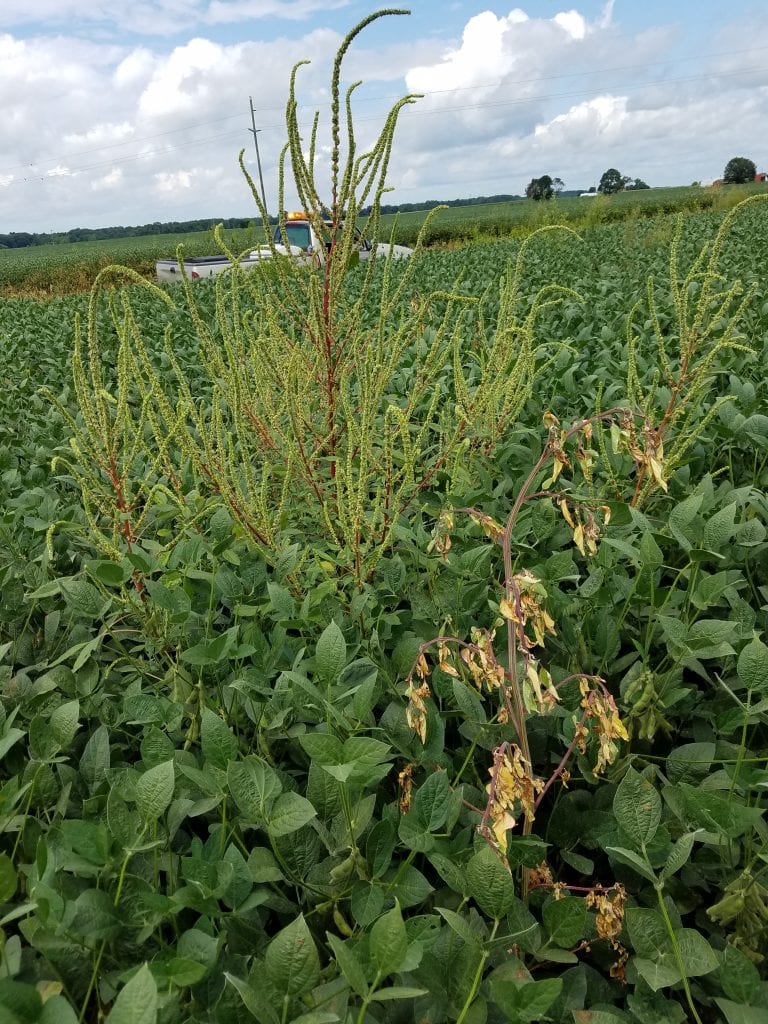Scott W. Rowe, Kent County Weed Control Coordinator, and Nate Richards, UME Ag Educator – Kent County

On August 8, 2018, Kent County Weed Control Coordinator, Scott Rowe, discovered a Palmer amaranth plant growing from a drainage gutter on Flatland Rd. (SR 514) in Chestertown. The identity of this plant was confirmed by University of Maryland Extension (UME) – Kent County Ag Educator, Nate Richards, other UME personnel and Mark VanGessel, University of Delaware Weed Science Professor.
Since that initial discovery, the Weed Control team have found or confirmed infestations on road rights-of-way and in fields across the county. Locations include Smithville Road area, Pomona, Massey and areas northwest and east of Chestertown. Some local growers and Ag Supply reps have reported having managed or treated infestations in Kent County prior to the 8/8/18 discovery. The infestations have been found in both non-organic and organic culture fields. Most infestations are light, involving one to several plants; however, a couple involve entire fields.
Palmer amaranth is a highly competitive annual pigweed that originated in the desert southwest and has been moving eastward and northward for several years. It reproduces by seed only; weed scientists report that a single plant can produce from 100,000 to 500,000 seeds. The tiny seeds are easily transported via field and road equipment, and ag commodities such as hay, straw, other feedstuffs and manure. Palmer amaranth has become established locally in southern Maryland, the lower Eastern Shore and lower Delaware. Populations in these areas are generally resistant to glyphosate (e.g., Roundup) and ALS inhibitors (e.g., Pursuit, Raptor, Accent, Harmony, FirstRate), and may have resistance to other herbicide classes.
Palmer amaranth can be distinguished from other pigweeds by its vegetative and reproductive parts: the main stems are hairless while redroot pigweed has a fuzzy stem; the leaf petiole (leaf stem) on larger Palmer plants – not on seedlings – is usually longer than the leaf blade while the petiole on other pigweeds is shorter; the inflorescence (flower stalks) of Palmer are longer, less branched, and less compact than redroot pigweed. The Penn State (PSU) website listed herein has excellent photo comparisons of the different pigweeds, and photos showing the difference between the male (pollen producing) and female (seed producing) plants of Palmer amaranth.
Now that it’s here, what to do? Since Palmer amaranth is such a prolific seed producer and there are limited effective herbicides for control, it is essential to manage it ASAP so it doesn’t get out of hand. Growers should scout their fields now. If they have very light to light infestations, they should hand pull all plants that have headed, or at least the female plants, bag them, remove them from the field and bury or burn them. The large paper lawn and leaf bags work well for burning. If plants haven’t headed, pull them and let them lie, making sure they can’t re-root. During harvest, growers should consider harvesting infested fields last and thoroughly cleaning combines and other equipment before leaving any infested field. If combine operators discover a patch during harvest, they should consider leaving the patch for later, bagging/burning ASAP, and recording the location for intense management next season.Combines, stalk cutters and tillage equipment are wonderful seeders!
The time to start managing Palmer amaranth is NOW! Growers should watch for publications and workshops that will be forthcoming and do what they can to learn how to manage this pest. The websites listed herein are excellent resources to help understand Palmer amaranth and its management. Some of the content in this article was gleaned from these websites.
https://blog.umd.edu/agronomynews/2017/04/06/management-of-palmer-amaranth-in-2017/
https://extension.psu.edu/invasive-pigweeds-palmer-amaranth-and-waterhemp#section-14
https://ag.purdue.edu/btny/weedscience/documents/palmer_bio_id_mngmt_pg.pdf
